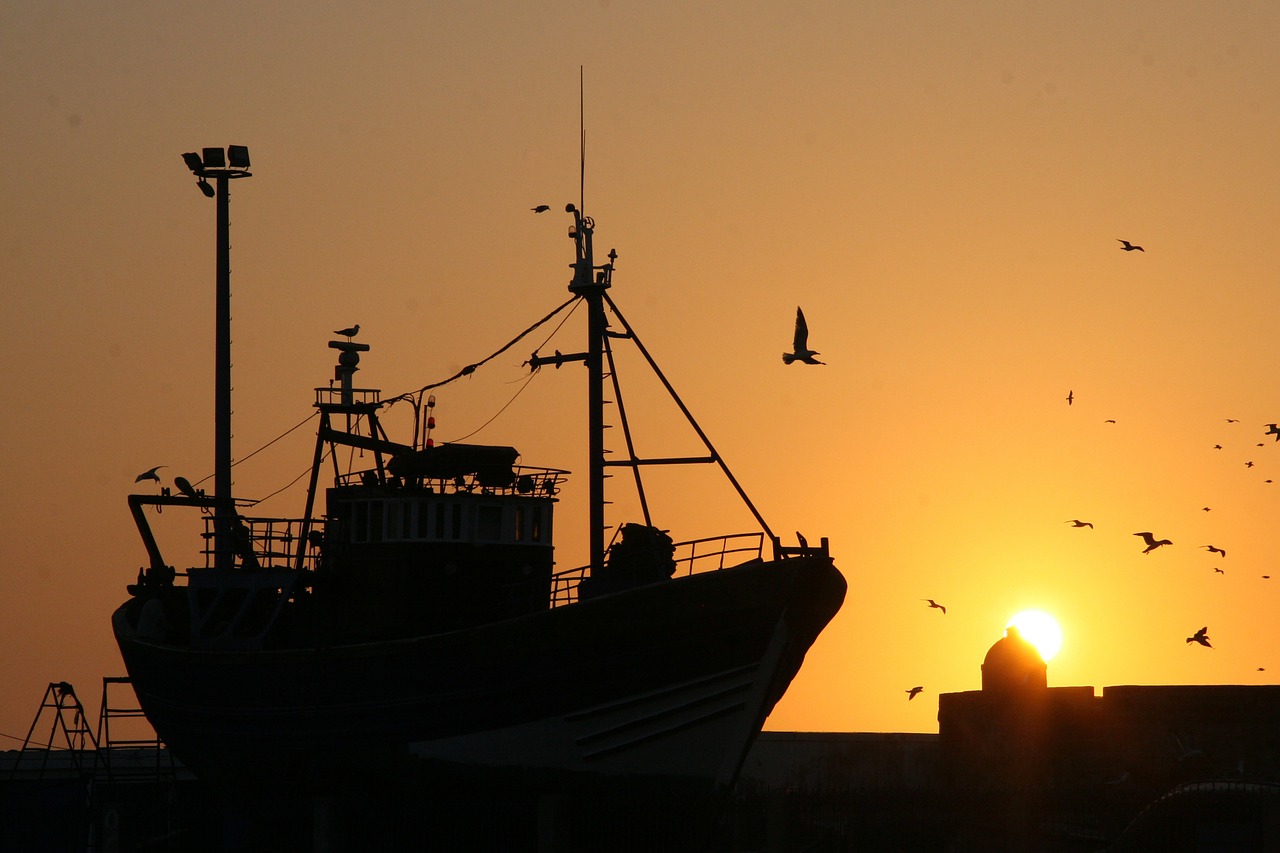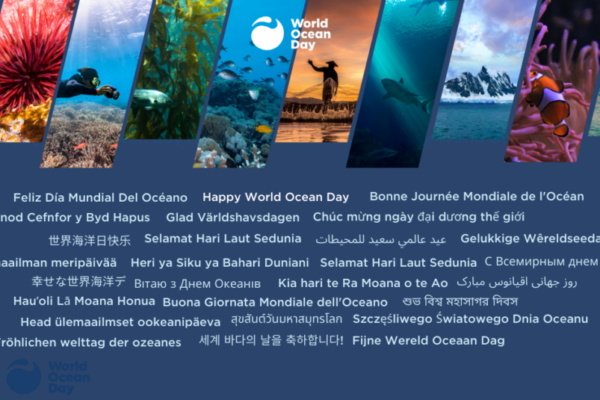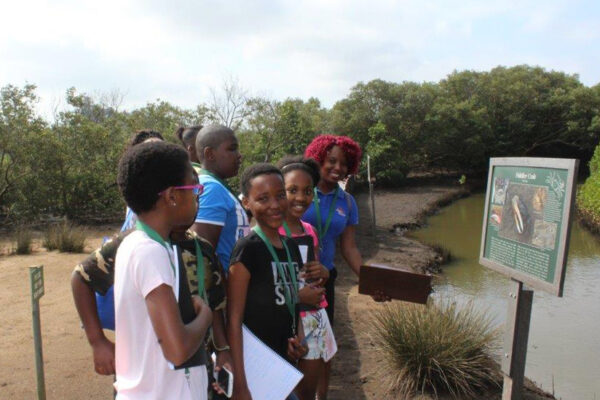The question: Can we engage the visiting public about science-based fisheries management in a way that raises their awareness, documents their opinions, and enhances their experiences?
The answer: Yes, yes and yes!
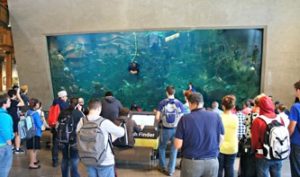
Visitors to the Seattle Aquarium listen to the messaging during a diver talk.
That is the topline finding from a pilot project completed by The Ocean Project in collaboration with Mystic Aquarium, Seattle Aquarium and the Texas State Aquarium, as part of an initiative launched last year with support from the Gordon and Betty Moore Foundation.
The background
As described in our initial post about this pilot project, we knew that Congress soon would be reconsidering our national fisheries policy, yet we also knew that many people beyond the Beltway didn’t even know that this policy was in place, let alone that it has been a success. With that in mind, we set out to develop an engagement that would inform visitors about the approach underlying the policy and ask if they too shared the view that as a nation we should continue on a course set not by special interests but by sound science.
Working backwards from that ‘ask,’ we then mined the lessons learned from The Ocean Project’s national public opinion research and Innovative Solutions Grants+ (ISG+) program, combined that with the aquariums’ local knowledge and prior experience, and developed a common story framework.
- Begin with the news of a local species that is recovering
- Add the carryover benefits brought by that recovery to the surrounding ecosystem and/or local economy
- Connect this success back to national policy, while giving the visitor a supporting role by citing sustainable seafood choices
- Relay the urgency, and ask if visitors will join in a show of support together with the aquarium
While the stories were similar, each site opted for a different type of engagement, so we also thought we’d gain some additional insights by comparing and contrasting the different results, and we certainly did.
- Mystic Aquarium created and presented a 1.5-minute video PSA in their marine theater prior to the start of each sea lion show
- Seattle Aquarium decided to incorporate this messaging into a 10-minute dive show
- The Texas State Aquarium served up the messaging along with red snapper samples
To evaluate our effort, we used three common methods (with special thanks here to Kathayoon Khalil of the Seattle Aquarium for her extra efforts around the evaluation).
- We tracked response rates for the comment cards
- We informally collected staff feedback about delivering the message and making the ask, as well as about visitor response to the ask and the request to complete an exit survey
- We conducted quantitative visitor exit surveys, and notably a lot of exit surveys, then analyzed the results and compared responses from engaged (those who received the messaging) and un-engaged (those who did not, or did not remember, receiving the messaging) visitors
And the results are in!
The overall results were remarkably clear and consistent, and very much in keeping with the foundational finding from our earlier efforts that visitors expect, trust and appreciate information about how they can help advance conservation efforts, even when, as in this case, we were engaging them directly on a policy issue as opposed to a personal behavior, as we had done much more of the latter in the past.
Engaging visitors via the PSA proved to be the most effective approach overall, but, as we explain below, that is only part of the story!
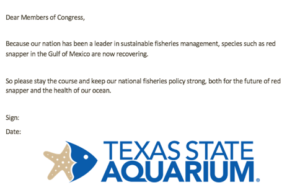
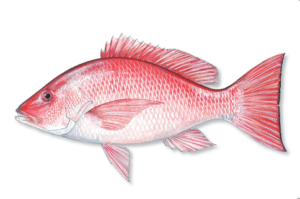
The comment card used at the Texas State Aquarium, showing a picture of a Red Snapper courtesy of www.fishwatch.gov, a site by NOAA that provides useful background information on various species.
A surprisingly high percentage of visitors were willing to sign a comment card to Congress
The highest completion rate actually came with the serving of the seafood samples, where a remarkable 62% of those engaged in that way were willing to sign a card. Yet this approach also required, by far, the most additional time and effort, from preparing and serving the samples to delivering the one-on-one messaging.
A more effective approach in terms of time and effort proved to be the showing of the PSA, which took time to make but then was merely a matter of introduce, press and play in the context of a show that was happening anyway. More than 12% of those shown the PSA on the three test days took the time to sign a card, and, cleverly, staff got the best response after posting the cards to a wall where at the end of the show guests could easily stop and sign one. Yes, we know that 12% is nowhere near 62%, but we also found that many more people could be shown the PSA and the burden on staff was much lower. Moreover, the aquarium could keep showing the PSA and collecting cards well beyond the test days with little additional effort, so in terms of reach it simply could not be beat.
The dive show actually had the lowest card completion rate, at just under 6%, but as we’ll see below, the best message retention.
Perhaps the most striking findings could be found in the exit surveys
The sites used iPads to survey more than 1,000 visitors in total, asking each visitor selected a series of questions about their thoughts on seafood sustainability, their perceptions of current fisheries policy, and their opinions related to the role of aquariums in advancing conservation, as well as their overall experience on that day. Then only at the end of the survey were visitors asked if they had been engaged on the fisheries issue by either watching the video, hearing the story during the diver’s talk, or trying the seafood sample, depending on the site.
When segmenting the results according to the response to that final question, we were admittedly pleased to find that the engagements not only had an impact, but that in many instances the differences between those who were and were not engaged were statistically significant.
- Across the sites, visitors who were engaged reported a higher level of concern about the future availability of ocean seafood, a higher level of familiarity with the concept of sustainable seafood, and, a greater belief that their seafood purchases impacted fish populations in the ocean.
- Across the sites, visitors who were engaged reported higher awareness of how some fish populations were starting to recover, which, of course, was the core of our story; and at two of the three sites they clearly connected that recovery with a science-based approach to fisheries policy.
- Across the sites, visitors also relayed an appreciation for having been engaged, with that group typically expressing more conviction about the role of aquariums in conservation, more trust in the information aquariums provide about conservation, and a greater belief that actions taken with aquariums could make a difference for conservation
- Last but not least, the results suggest that Net Promoter Scores, even if already high, go even higher when visitors are asked to join in a conservation action
For a full presentation of the results, watch this recorded webinar. In those full results, one can also see that the visitors who received the messaging during the dive show seemed to be the most likely to retain and appreciate the information, followed closely by those who received the information from the PSA. The message retention from the seafood sampling was not as strong, especially on the points of policy and aquarium involvement, noting two likely reasons for this. First, staff understandably found it difficult to deliver the full messaging while also serving up the samples, or, perhaps, and please forgive the pun, visitors simply found it difficult to digest it all. Second, that site used offline survey collection software that many visitors found to be ‘clunky’ when compared to the SurveyMonkey interface used where WiFi was available.
Now for a word from our interpreters
The informal feedback from staff was overwhelmingly positive. Staff were especially keen on the story framework, and the way it began with a success story, with one of the interpreters from Seattle commenting, “It felt good to share a conservation success story (and) overall, we felt a very positive response from the visitors.” That sense of a positive response from visitors was echoed by staff from the other aquariums, with a staff member from Mystic adding, “Several (visitors) thanked us for the signature-collection effort – some seemed genuinely heartened to be part of ‘something bigger’ just by signing their names.” Staff from the Texas State Aquarium shared some of the above sentiments, while also flagging the aforementioned challenge of trying to serve up the samples along with the messaging, and adding that in hindsight, as one staff member put it, “I am kind of kicking myself because we didn’t include Spanish!”
As for collecting the exit surveys, the sites had somewhat different experiences. Apart from wishing that we had also done the survey in Spanish, the staff at the Texas State Aquarium reported a lot of enthusiasm for the survey, so much so that it became a challenge to keep the sampling randomized. At Seattle, the response rate was in keeping with what many of the ISG+ partners had reported, where, “about two thirds to three fourths of the people asked agreed to take the survey.” Meanwhile at Mystic, which was experiencing some of its busiest days on record, staff sometimes struggled to find visitors willing to take the survey.
Going forward
What could have been better?
- In terms of the messaging, we might consider moving the ask up in the story, and putting additional emphasis on the pressing need to keep the policy strong, as that urgency did not resonate as well as we might have liked, but overall we were pleased with the framework.
- As for the approaches, testing three different ways to deliver the messaging proved to be a wise idea, but going forward we’d likely emphasize a combination of group presentations and, where feasible, showing a short video PSA, especially in settings where you may have an attentive audience.
- With the evaluation, having a large and reliable exit survey sample gave us confidence in our findings, but we noted that it could be difficult to get visitors to participate even for just a three-minute survey, so we would look for ways to further increase response, provide the text in English and Spanish, and would only use the more reliable online (as opposed to offline) software.
But going back to the big picture, this pilot certainly provides a promising foundation on which to build any effort aimed at bringing the visiting public into public policy, and the need to engage the visiting public on the specific issue of fisheries policy certainly has not gone away.
The general recommendations coming out of the pilot project were as follows:
- Don’t be afraid to bring visiting public into public policy!
- Design your public engagement based on policy goal
- Carefully craft your messaging
- Choose the most appropriate engagement approach
- Maximize the opportunity in scripted presentations & shows
- Be prepared to leverage visitor interest
And the next steps around engaging the public on the fisheries issue? Please let us know if your aquarium, zoo or museum is interested in becoming involved, whether as a ‘twist’ to your ongoing seafood sustainability messaging or as a new effort entirely.
Please stay tuned as we hope to have more to announce soon. In the meantime, if you’re involved with AZA, please mark your calendars for “Putting the Public in Public Policy,” a session at 2PM on September 26 during the AZA Annual Conference in Seattle that will feature more lessons from this pilot and other efforts.

